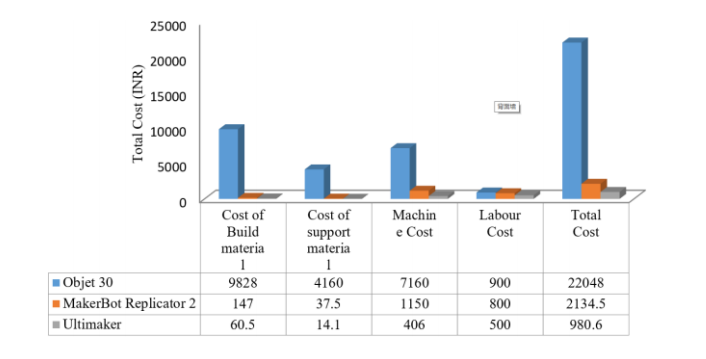India: Polyjet Versus FDM 3D Printing Errors Compared
In ‘Comparative Study and Measurement of Form Errors for the Component Printed by FDM and PolyJet Process,’ authors Nagendra Kumar Maurya, Vikas Rastogi, and Pushpendra Singh (all researchers from India) explore the differences between FDM 3D printing and polyjet 3D printing—for the purposes of rapid prototyping.
For the fused deposition modeling (FDM) system, testing was performed on both an Ultimaker 2 and a MakerBot Replicator 2. For polyjet, the Objet30 (manufactured by Stratasys) was used.
“CATIA-V6 was used for the 3D modeling and a coordinate measuring machine (CMM) was employed for the measurements of dimensions. Optical profilometer was considered to measure the surface roughness of component. ISO UNI EN 20286-I (1995) and DIN 16901 standards was used for the evaluating IT grades for each selected dimension,” explained the researchers.
A sample automotive connecting rod was created on all the printers to compare and evaluate:
- Dimensional accuracy
- Form error
- Surface roughness
- Cost analysis
- Tolerance grade (of automotive parts)
The researchers used four different types of dimensions during their comparative analysis:
- Linear dimension in X-Y plane
- Linear dimension Y-Z plane
- Radial dimension
- Circular dimension
The researchers clearly observed better performance via polyjet printing on the Objet30, especially in dimensional accuracy; this was the exception however, as FDM parts printed along the Y-Z plane offered better form. They also noted an issue with dimensions overall, as they were smaller than that of the CAD model in almost all cases. This discrepancy was attributed to shrinkage during the fabrication process—and more so in FDM printing rather than polyjet (due to ‘air gapes’). Polyjet 3D printing was found to cause greater dimensions across the Y-Z plane, however, as a base is formed on the platform.
Experimental results also showed parts created via polyjet technology had ‘superior surface quality.’ In comparison, FDM components exhibited greater surface irregularity.
Other major findings showed:
- Objet30 has minimum percentage error along the XY plane
- MakerBot had minimum percentage error along the YZ plane.
- Polyjet parts showed minimum form error.
- Total cost prototype generated through Objet 30 was very high as compared to Ultimaker and MakerBot.
“Total cost of prototype generated by different 3D printers was calculated based on cost of build material, cost of support material, labor cost and machine cost. The results of measurement show that quality of prototype fabricated by Objet30 is better than Ultimaker and MakerBot. Form error and surface roughness of objet30 printer was good enough to produce industrial grade prototype,” explained the researchers. “The novel contribution of this work lies in the fact that no such studies were conducted using complex shape geometry in the archival literature.”
Comparisons in technique are important as users today are engaged in so many different 3D printing research studies, as well as innovating for automation and design, industrial manufacturing, and of course—creating new items that may not have ever been possible before with the use of conventional technology.
What do you think of this news? Let us know your thoughts! Join the discussion of this and other 3D printing topics at 3DPrintBoard.com.
[Source / Income: ‘Comparative Study and Measurement of Form Errors for the Component Printed by FDM and PolyJet Process’]Subscribe to Our Email Newsletter
Stay up-to-date on all the latest news from the 3D printing industry and receive information and offers from third party vendors.
Print Services
You May Also Like
RAPID 2025: Stratasys & trinckle Announce Strategic Software Partnership
News continues to flood in from last week’s RAPID+TCT 2025, including a new partnership between AM market leader Stratasys and Berlin-based software company trinckle. By automating important steps in fixture...
RAPID TCT 2025: Spring in the Paris of the Midwest
I’m going to go out on a limb here and say that whomever coined the phrase Detroit: Paris of the Midwest, had not spent a lot of time in Paris...
3D Printing Financials: 3D Systems Looks to Bounce Back in 2025
After a challenging year for the industry, 3D Systems (NYSE: DDD) ended 2024 with results pointing to a reset, laying the groundwork for future profitability. The company didn’t post strong...
Printing Money Episode 27: Q4 2024 Public 3D Printing Earnings Review with Troy Jensen, Cantor Fitzgerald
Q2 2025 has already begun, but public markets reporting has only just finished with Q4 2024. To tie a bow on Q4 2024, we are thankful to have Troy Jensen...































